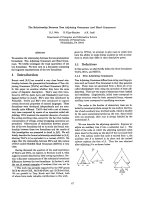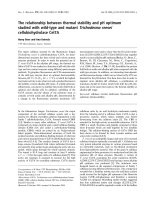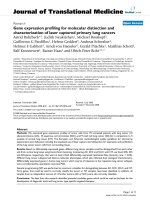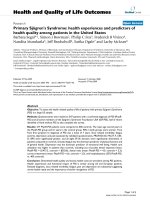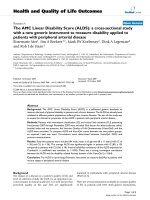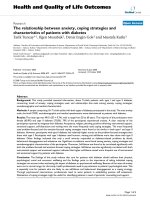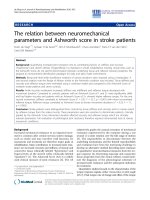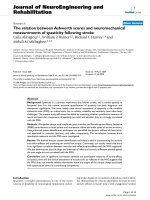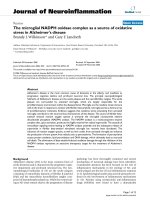báo cáo hóa học: " The relationship between anxiety, coping strategies and characteristics of patients with diabetes" docx
Bạn đang xem bản rút gọn của tài liệu. Xem và tải ngay bản đầy đủ của tài liệu tại đây (258.65 KB, 9 trang )
BioMed Central
Page 1 of 9
(page number not for citation purposes)
Health and Quality of Life Outcomes
Open Access
Research
The relationship between anxiety, coping strategies and
characteristics of patients with diabetes
Tarik Tuncay*
1
, Ilgen Musabak
2
, Deniz Engin Gok
3
and Mustafa Kutlu
3
Address:
1
Faculty of Economics and Administrative Sciences, Department of Social Work, Hacettepe University, Fatih Cd. No.195 PK.06290
Kecioren – Ankara, Turkey,
2
Department of Social Services, Gülhane Hospital, Etlik – Ankara, Turkey and
3
Department of Endocrinology, Gülhane
Hospital, Etlik – Ankara, Turkey
Email: Tarik Tuncay* - ; Ilgen Musabak - ; Deniz Engin Gok - ;
Mustafa Kutlu -
* Corresponding author
Abstract
Background: This study provided essential information, about Turkish patients with type I and type II diabetes,
concerning: levels of anxiety, coping strategies used, and relationships that exist among anxiety, coping strategies,
sociodemographic and medical characteristics.
Methods: A sample comprising 161 Turkish adults with both types of diabetes participated in the study. The trait anxiety
scale, the brief COPE, sociodemographic and medical questionnaire were administered to patients with diabetes.
Results: The mean age was 49.01 (SD = 9.74), with a range from 20 to 60 years. The majority of the participants were
female (60.9%) and type II diabetes (75.8%). 79% of the participants experienced anxiety. A clear majority of the
participants reported to integrate their diabetes. Acceptance, religion, planning, positive reframing, instrumental support,
emotional support, self-distraction and venting were the most frequently used coping strategies. The most frequently
used problem-focused and the emotion-focused coping strategies were found to be similar in both type I and type II
diabetes. However, participants with type II diabetes had relatively higher scores on the problem-focused strategies than
those with type I. Participants with type I diabetes used humour, venting and self-blame more than those with type II
diabetes. Other findings indicated that only a small minority responded to diabetes-related problems by denial,
behavioural disengagement and substance use. Significant correlations were found among anxiety, coping strategies and
sociodemographic characteristics of the participants. Moreover, Self-blame was found to be correlated significantly with
both the problem-focused and emotion-focused coping strategies. Self-blame was also significantly correlated with both
instrumental support and emotional support indicated that higher self-blame caused more frequent use of instrumental
and emotional support by patients with diabetes.
Conclusion: The findings of this study indicate that care for patients with diabetes should address their physical,
psychological, social and economic wellbeing and the findings point to the importance of taking individual coping
strategies into account when evaluating the impact of diabetes on psychosocial wellbeing. Because of the mean of anxiety
were not in normal range, for this study, health professionals need to pay attention to patient's psychological state. This
is especially true for patients who are likely to use self-blame and behavioural disengagement as a coping strategy.
Through psychosocial interventions, professionals need to assist patients in establishing positive self evaluations.
Delineation of coping strategies might be useful for identifying patients in need of particular counselling and support.
Published: 13 October 2008
Health and Quality of Life Outcomes 2008, 6:79 doi:10.1186/1477-7525-6-79
Received: 25 June 2008
Accepted: 13 October 2008
This article is available from: />© 2008 Tuncay et al; licensee BioMed Central Ltd.
This is an Open Access article distributed under the terms of the Creative Commons Attribution License ( />),
which permits unrestricted use, distribution, and reproduction in any medium, provided the original work is properly cited.
Health and Quality of Life Outcomes 2008, 6:79 />Page 2 of 9
(page number not for citation purposes)
Background
Medical advances throughout the 20th century have
resulted in the transformation of many acute and once
incurable illnesses into chronic conditions. As a result, the
prevalence of chronic diseases, and the prevalence of dia-
betes in particular, has increased rapidly. In addition,
environmental factors such as pollutants, and lifestyle
changes such as sedentary habits and overeating have also
contributed to the rise in chronic illnesses. Consequently,
diabetes is one of the most challenging and burdensome
chronic diseases of the 21st century, and it is a growing
threat to the world's public health [1,2]. The treatments
for diabetes and its associated health-risk factors are often
highly complex and require considerable patient educa-
tion and frequent medical monitoring [3]. At the same
time, diabetes carries with it a considerable amount of
stress. People on insulin must learn how to regulate their
blood sugars by monitoring blood glucose levels daily
while carefully attending to their food intake and an exer-
cise regimen. Careful blood glucose monitoring is neces-
sary to prevent wide variations in blood sugars that affect
both short term and long term health and functioning.
Hypoglycemic reactions are a concern in the short run not
only because they are frightening and disruptive, but also
because, when severe, they can lead to unconsciousness,
coma and death [4].
The constant stress of maintaining tight glycemic control
can result in two types of psychological distress (a) sub-
clinical emotional distress, and (b) diagnosable psycho-
logical disorders [5]. Additionally, psychiatric conditions
can occur independently without being a consequence of
diabetes. It has been shown that individuals with diabetes
have a disproportionately higher rate of psychiatric disor-
ders [6,7], with affective and anxiety disorders being more
commonly diagnosed than in the general population [8].
This is evidenced by research showing high rates of psychi-
atric disorders, particularly depression and anxiety, in a
sample of Turkish patients with diabetes. For example,
Fettahoglu et al., [9] found over 40% increased risk in hav-
ing any type of psychiatric disorder in patients with diabe-
tes, and Gülseren et al. [10] found that depression and
anxiety account for 45% of psychiatric disorders in
patients with diabetes. These results show the negative
impact that diabetes can have on an individual's psycho-
social adjustment, and the need for research to determine
the most appropriate and common coping strategies to
deal with the stress of illness.
The coping strategies used to deal with diabetes can play a
key role in the maintenance and duration of, and psycho-
social adjustment to diabetes [11-13]. In terms of which
coping strategies are used to deal with diabetes, there is
much debate as to whether the individual's appraisal of
the illness as controllable or uncontrollable plays a role in
choice of coping strategy and in the outcomes associated
with the illness. In response to these issues, this study
investigated diabetes-related coping strategies and their
relationship to anxiety and sociodemographic characteris-
tics of patients with type I and II diabetes.
Coping
Coping has been defined as a response aimed at diminish-
ing the physical, emotional and psychological burden that
is linked to stressful life events and daily hassles [14].
Coping is understood to be adaptational activity that
involves effort. It is the element of effort which enables us
to draw the distinction between coping and ready-made
adaptational devices such as reflexes. Coping constitutes
constantly changing cognitive, behavioural and emo-
tional efforts to manage particular external and/or inter-
nal demands that are appraised as taxing or exceeding the
resources of the individual [15].
Essentially, coping strategies are separated into emotion-
focused and problem-focused. An emotion-focused strat-
egy emphasizes that patients try to process their emotions
by acting and thinking. When patients use a problem-
focused strategy, they believe that they can affect the situ-
ation that was caused by their disease or affect their
resources to manage the situation, and this type of strategy
is important to maintain quality of life. Emotion-focused
and problem-focused coping strategies may be used
simultaneously or alternately. It is therefore difficult to
discriminate between them in the coping process [16-18].
The outcome of the coping process is adaptation or mala-
daptation. Adaptation is defined as the degree to which
patients cope psychologically, socially and physiologi-
cally with their chronic illness [19].
Coping with the implications of one's diabetes related
problems could be a difficult and often lifelong process.
Patients may cope by adjusting their social role to fit the
demands and challenges associated with the illness, or
they may cope by trying to reframe their experiences view-
ing the situation in a more positive light. Accepting the
reality of the diagnosis and developing a positive attitude
toward treatment is thought to be critical for successful
coping and recovery [20].
Coping is considered one of the core concepts in health
psychology and in the context of quality of life, and is
strongly associated with the regulation of emotions
throughout the stress period [21]. But there is no consen-
sus as to which coping strategies are most effective, and
how well a coping strategy serves the purpose of solving
problems, relieving emotional distress. However, previ-
ous research has shown that emotion-oriented coping
strategies in the long run may be less adaptive than prob-
lem-oriented strategies, although the impact of these cop-
Health and Quality of Life Outcomes 2008, 6:79 />Page 3 of 9
(page number not for citation purposes)
ing strategies appears to depend on the specific
constraints imposed by the stressful situation [22,23].
While this is true, it has also been suggested that use of
problem-focused or emotion-focused strategies might be
dependent on the nature of the illness. For example, it has
been suggested that persons with chronic illnesses such as
myalgic encephalomyelitis/chronic fatigue syndrome
(ME/CFS) with no definite cure may ascribe their illness
to uncontrollable factors and therefore tend to use more
emotion-focused coping strategies [24,25]. Therefore, it is
possible that when an illness is associated with controlla-
ble factors, individuals with the illness engage in prob-
lem-focused solutions but when the illness is not
amenable to cure or factors that are controllable, the ten-
dency to use more emotion-focused strategies may
emerge. Based on this premise, it is expected that persons
with a chronic illness such as diabetes may use both prob-
lem-focused and emotion-focused strategies. Whereas
problem-focused strategies might be used to better man-
age the physical need to monitor and administer insulin
as needed and also maintain a healthy diet, the emotion-
focused strategies might be evoked by the stress associated
with knowing that there is currently no cure for diabetes.
In conclusion, coping strategies are related with the regu-
lation of emotion, especially anxiety, throughout the ill-
ness process of patients with diabetes, and many studies
have shown that problem-focused coping strategies are
associated with less anxiety, while emotion-focused ones
are associated with more anxiety [21,23,26]. However, the
adaptive qualities of various coping strategies must be
evaluated in the specific context where they occur.
Because of the lack of community health care in Turkey,
the psychological state and coping strategies of patients
with diabetes are unclear and need to be identified. How-
ever, no relevant studies in Turkey could be located. To
address this gap of knowledge, the objectives of this study
were to explore and describe in Turkish patients with type
I and type II diabetes: (1) levels of anxiety, (2) coping
strategies used, and (3) relationships among medical,
sociodemographic characteristics, anxiety and coping
strategies.
Methods
Participants and procedures
The convenience sampling method was used in this study.
Patients with disease duration of less than six months and
with severe physical co-morbidity were excluded from the
study. Each participant was informed, prior to the inter-
view, about the purpose of the study, written informed
consent was obtained, and participants were told that they
had the right to refuse participation and could withdraw
at any time. One hundred and eighty-nine (189) people
with diabetes completed the questionnaire. Out of these,
twenty-eight (28) participants were excluded from the
study due to poor response quality. Those excluded were
mainly older people (mean age of 54.1 years), reporting
low level of education, and had not given response to at
least 70% of items of the scales. Finally, One hundred and
sixty-one (161) patients (98 female, 63 male) participated
in the study. Written informed consent was approved by
the Gülhane Hospital's ethical review board and obtained
from each participant prior to the interview (See Table 1).
Sociodemographic and medical characteristics of the par-
ticipants are presented in Table 1 (n = 161). The mean age
of the participants with diabetes was 49.01 (SD = 9.74),
with a range from 20 to 60 years, and their mean duration
of diabetes was 10.17 (SD = 7.2). All of the patients were
recruited from the diabetes clinic of the Gülhane Hospital.
The majority of the participants were female (60.9%),
married (80.7%), living in a nuclear family system
(91.9%), unemployed (85.7%), living in a flat (79.5%)
(middle-class family), and type II diabetes (75.8%). The
distribution of educational status was: (1) primary school
Table 1: Sociodemographic and medical characteristics of the
participants (n = 161).
Variables n (%)
Gender
Female 98 (60.9)
Male 63 (39.1)
Age (years) mean (SD); range 49.01 (9.74); 20–60
Marital status
Single 11 (6.8)
Married 130 (80.7)
Widowed 20 (12.5)
Educational status
Primary school 71 (44.1)
Secondary school 14 (8.7)
High School 39 (24.2)
University (undergraduate degree) 37 (23.0)
Monthly income (New Turkish Lira-YTL)
Up to 500 21(13.1)
501–1000 57 (35.4)
1001–1500 23 (14.3)
1501–2000 35 (21.7)
Over 2001 25 (15.5)
Family Type
Nuclear 148 (91.9)
Extended 13 (8.1)
Employment status
Employed 23 (14.3)
Unemployed 138 (85.7)
Type of settlement
Flat 128 (79.5)
Slums 33 (20.5)
Type of Diabetes
Type 1 39 (24.2)
Type 2 122 (75.8)
Duration of Diabetes (years) mean (SD); range 10.17(7.2); 1–32
Health and Quality of Life Outcomes 2008, 6:79 />Page 4 of 9
(page number not for citation purposes)
level, 44.1%, (2) secondary school level, 8.7%, (3) high
school level, 24.2%, and (4) university level, 23.0%.
Instruments
Anxiety was assessed using the trait scale of the Spielberger
State-Trait Anxiety Scale. This is a well-validated, twenty-
item, four-option response format instrument, with scale
scores adjusted to fall between 20 and 80. Previous studies
have identified a normative score of 25, and a clinically
significant score of 42. Acceptable validity and reliability
has been reported in various populations [27,28]. The
validity and reliability of this inventory for Turkish society
were studied by Öner and LeCompte [29].
Carver, Scheier, and Weintraub [16] developed the COPE
as a comprehensive questionnaire of 15 theoretically
derived coping styles or strategies. An abbreviated version
of the COPE has been developed – the brief COPE [30].
The scale was administered to assess patients' coping strat-
egies. In health psychology, the COPE and the brief COPE
have predicted clinically relevant outcome across many
stressful situations and populations [e.g., [16,30-33]]. The
brief COPE Scale is a 28-item self report measure of prob-
lem-focused versus emotion-focused coping skills. The
scale consists of 14 domains/sub-scales (self-distraction,
active coping, denial, substance use, use of emotional sup-
port, use of instrumental support, behavioural disengage-
ment, venting, positive reframing, planning, humour,
acceptance, religion, self-blame) of two items each. Partic-
ipants are asked to respond to each item on a four-point
Likert scale, indicating what they generally do and feel
when they experience diabetes-related stressful events (1 =
I have not been doing this at all – 4 = I have been doing
this a lot). The higher the score on each coping strategy,
the greater the use of the specific coping strategy.
The brief COPE scale has good internal consistency and
test-retest reliability, and concurrent validity has been
established. The validity and reliability of this inventory
for Turkish society were studied by Tuna [34]. In this
study, Cronbach's Alpha of the brief COPE Scale was
found to be .82. With regard to the internal consistency of
the fourteen sub-scales for assessing coping strategies, the
following Cronbach's alphas were found: acceptance .82,
religion .77, planning .75, positive reframing .87, using
instrumental support .76, active coping .83, using emo-
tional support .71, humour .89, self-distraction .73, vent-
ing .84, self-blame .92, behavioural disengagement .81,
denial .96, and substance use .92. The scales are only two
items each, their reliabilities all meet or exceeded the
value of .50 regarded as minimally acceptance [16,35].
The researchers developed a sociodemographic question-
naire including gender (1 = female; 2 = male), age, marital
status, educational status, monthly income, family type,
employment status, type of settlement, and type and dura-
tion of diabetes. These variables were implemented as
control variables. Type and duration of diabetes were
determined by self-report, asking whether the participants
have type I or II diabetes. Self-reports of diabetes type were
validated against the patients' medical records from the
diabetes clinic. The data were consistent.
All data were collected by two of the researchers between
June 2007 and February 2008 in the diabetes clinic of Gül-
hane Hospital. The researchers obtained permission to
collect data, from the ethical review board of the Gülhane
Hospital.
Statistical analyses
The analyses were conducted using the SPSS program ver-
sion 14.0. Statistical analyses included descriptive statis-
tics, reliability testing, and Pearson product moment
correlation among variables. In descriptive statistics, pro-
portion is used to describe categorical and numerical var-
iables; mean and SD are used to describe continuous
variables. In association analyses, Pearson correlation
coefficients are calculated to examine the relationships
among the all variables. Levels of significance are indi-
cated at both .05 and .01 in the correlation table. Internal
consistency of the brief COPE scale was estimated using
Cronbach's alpha coefficients. Participants who had given
response to at least 70% of items included in any scale
were included in the study.
Results
The total mean and standard deviation of trait anxiety in
two types of diabetes was 46.98 ± 6.14. The mean of trait
anxiety score of patients with type I diabetes was found to
be a relatively higher (48.61 ± 5.20) than those with type
II diabetes (46.46 ± 6.35). 79% (n = 127) of the partici-
pants exceeded a trait anxiety threshold score of 42.
The most used problem-focused coping strategies in both
type I and type II diabetes included (table 2): acceptance
(7.22 ± 1.07), religion (7.07 ± 1.31), planning (6.77 ±
1.07), positive reframing (6.55 ± 1.25), using instrumen-
tal support (6.47 ± 1.62), active coping (6.15 ± 1.61), and
using emotional support (5.94 ± 1.64). The most used
emotional coping strategies were self-distraction (6.36 ±
1.43) and venting (5.35 ± 1.20). The most frequently used
problem-focused and the emotion-focused coping strate-
gies were found to be similar in both type I and type II dia-
betes. However, participants with type II diabetes had
relatively higher scores on the problem-focused strategies
than those with type I diabetes (see Table 2).
The correlation coefficients among sociodemographic,
medical variables, anxiety and coping strategies are pre-
sented in Table 3. All tests were two-tailed and conducted
Health and Quality of Life Outcomes 2008, 6:79 />Page 5 of 9
(page number not for citation purposes)
at 5% significance. Coefficients of correlations between
age, type of diabetes and duration of diabetes, gender,
educational status and monthly income were significant,
whereas the correlations between type of diabetes and
gender, educational status and family type were non-sig-
nificant. However, strong positive correlations were found
among type of diabetes and age, whereas type of diabetes
was negatively associated with educational status, indicat-
ing that people with type II diabetes in the present study
are older and less educated than those with type I.
The mean trait anxiety scores were positively correlated
with gender, educational status, and monthly income.
Males had higher levels of anxiety than females, individu-
als with higher degree of education had more anxiety than
those with less education and persons who have higher
monthly income had higher levels of anxiety than individ-
uals with less monthly income.
Strong significant correlations were found among the
problem-focused coping strategies. These were planning,
positive reframing, religion, instrumental support, active
coping and emotional support. Strong significant correla-
tions were also found among the emotion-focused coping
strategies. These were self-distraction, behavioural disen-
gagement, venting, self-blame, denial and substance use.
In addition, venting correlated significantly with both
problem-focused and emotion-focused coping strategies.
Religion, as a problem focused coping strategy, was found
to be negatively correlated with educational status and
monthly income indicates that patients with lower level
of education and monthly income more frequently use of
religious coping strategies. Religion was also significantly
correlated with positive reframing, emotional support
and self-distraction.
Instrumental support was significantly correlated with
emotional support, positive reframing and self-blame,
and negatively correlated with denial. Emotional support
were also positively correlated with religion, positive
reframing, instrumental support, active coping as prob-
lem-focused coping strategies, and self-distraction, vent-
ing, self-blame, behavioural disengagement as emotion-
focused coping strategies. Interestingly, self-blame was
significantly correlated with both instrumental support
and emotional support indicates that higher self-blame is
related to more frequent use of instrumental and emo-
tional support by patients with diabetes.
Discussion
This study explored anxiety and dimensions of problem-
focused and emotion-focused coping strategies -as meas-
ured by the brief COPE- in a sample of patients with type
I and type II diabetes. Almost 79% of the participants in
this study experienced anxiety related to their diabetes.
This percentage of anxiety is higher than those found in
previous research. Gülseren et al. [10] found that anxiety
was one of the problems reported with 34.4% by patients
with diabetes. These results show that while planning the
treatment of patients with diabetes, evaluating their men-
tal health might help to provide optimal treatment and
psychosocial care services. In addition, participants with
Table 2: Means and standard deviations of trait anxiety and coping strategies of the participants of two types of diabetes (n = 161).
Type I Diabetes (n = 39) Type II Diabetes (n = 122) Total (n = 161)
Variables M (SD) Range M (SD) Range M (SD) Range
Trait Anxiety 48.61 (5.20) 41–59 46.46 (6.35) 29–63 46.98 (6.14) 29–63
Coping Strategies
Problem-focused coping strategies
Acceptance 6.69 (1.43) 3–8 7.40 (0.87) 5–8 7.22 (1.07) 3–8
Religion 6.97 (1.26) 4–8 7.10 (1.32) 2–8 7.07 (1.31) 2–8
Planning 6.48 (0.82) 5–8 6.86 (1.13) 4–8 6.77 (1.07) 4–8
Positive Reframing 6.33 (1.13) 4–8 6.62 (1.29) 3–8 6.55 (1.25) 3–8
Using Instrumental Support 5.51 (1.73) 2–8 6.08 (1.59) 2–8 6.47 (1.62) 2–8
Active Coping 5.69 (1.68) 3–8 6.30 (1.56) 3–8 6.15 (1.61) 3–8
Using Emotional Support 5.51(1.73) 2–8 6.08 (1.59) 2–8 5.94 (1.64) 2–8
Humour 4.58 (2.04) 2–8 3.90 (1.90) 2–8 4.07 (1.95) 2–8
Emotion-focused coping strategies
Self-Distraction 5.92 (1.64) 3–8 6.50 (1.33) 3–8 6.36 (1.43) 3–8
Venting 5.56 (1.12) 2–8 5.28 (1.22) 2–8 5.35 (1.20) 2–8
Self-Blame 4.69 (1.82) 2–8 4.04 (1.84) 3–8 4.20 (1.85) 2–8
Behavioural Disengagement 3.66 (1.57) 2–7 3.67 (1.62) 2–8 3.67 (1.61) 2–8
Denial 3.76 (1.51) 2–8 3.35 (1.63) 2–8 3.45 (1.60) 2–8
Substance Use 3.25 (1.66) 2–6 2.37 (1.25) 2–8 2.59 (1.41) 2–8
Health and Quality of Life Outcomes 2008, 6:79 />Page 6 of 9
(page number not for citation purposes)
Table 3: Correlations among sociodemographic – medical characteristics, anxiety and coping strategies (n = 161).
Variables 1 2 3 4 5 6 7 8 9 10 11 12 13 14 15 16 17 18 19 20 21 22
Sociodemographic characteristics
Age (1) 1 .00 17* 12 .13 .46** .21** .05 .01 .09 .21** .11 .06 .12 08 18* .10 03 14 .05 01 .13
Gender (2) 1 .46** .19* 00 02 13 .38** 02 08 10 10 08 29 09 10 -06 28** .02 27** .03 .10
Educational status (3) 1 .63** 07 13 15 .44** 00 24** .06 .02 02 24** 24** 01 .01 20** .01 29** 11 04
Monthly income (4) 1 13 08 03 .31** 05 30** 05 03 09 26** 08 .04 09 04 .01 23** 15 09
Family Type (5) 1 .16* .01 03 .04 .00 .00 .23** 01 .17* 03 05 .06 .03 04 09 05 .21**
Medical characteristics
Type of Diabetes (6) 1 01 15 .28** .04 .14 .09 .01 .16* .14 14 .17* 06 14 .00 11 26**
Duration of Diabetes (7) 1 .03 04 .03 .00 .06 15* 18* 33** .04 .06 07 04 02 01 .15
Trait Anxiety (8) 1 30** 39** 05 19* 13 05 29** 08 29** 23** 12 .01 .02 00
Coping Strategies
Problem-focused strategies
Acceptance (9) 1 .26** .24** .35** .05 .02 .11 .09 .17* 08 .01 20* 03 15*
Religion (10) 1 .03 .26** .11 .02 .24** 10 .21** .09 .08 .06 .05 03
Planning (11) 1 .31** .09 .32** .04 .04 .17* 12 .07 26** 08 06
Positive Reframing (12) 1 .29** .32** .25** .13 .33** .16* .09 12 00 04
Using Instrumental
Support (13)
1 .14 .31** 13 .09 .50 .34
**
.07 -
.16
*
.01
Active Coping (14) 1 .23** .10 .17* .02 12 .01 .14 .02
Health and Quality of Life Outcomes 2008, 6:79 />Page 7 of 9
(page number not for citation purposes)
type I diabetes had higher mean of anxiety score than
those with type II diabetes. This finding is consistent with
prior findings. Grigsby et al. [36] and Cohen & Kanter [26]
found that patients with type I diabetes experience more
anxiety than patients with type II diabetes, because of the
highly demanding and challenging regimen of diabetes
and insulin dependency.
Coping theorists often emphasize the benefits of problem
focused coping, such as acceptance, positive reframing,
and turning to religion or spirituality [30,37]. A consider-
able number of research with various patient groups show
that an increase in the functioning of spiritual or religious
coping in the patients with diabetes decreases anxiety,
depression, and hopelessness, and stimulates psychologi-
cal functions, adaptation to the illness process, life satis-
faction, and quality of life [e.g., [5,38,39]]. In a research
with various chronic illnesses including diabetes by Rowe
and Allen [39], the relationship between spirituality and
coping was analyzed. A positive correlation was identified
between the increase in the interpersonal and transcen-
dental connectedness of the patients and their psycholog-
ical wellbeing and functions. The present study
documented some evidence for such benefits, in those
patients with diabetes. The problem-focused coping strat-
egies most frequently used, in this study, were acceptance,
religion, planning, positive reframing, using instrumental
support, active coping, and using emotional support. Self-
distraction and venting considered emotion-focused strat-
egies were also used. These findings also imply that most
of the participants positively appraised their stressful and
threatening disease and attempted to develop effective
coping strategies to maintain their psychosocial wellbe-
ing.
An encouraging finding from the present study was that
the majority of the participants responded to their diabe-
tes-related problems by problem-focused coping strate-
gies instead of emotion-focused coping strategies such as
behavioural disengagement, denial, and substance use.
Although the problem-focused and the emotion-focused
coping strategies were used in similar frequency by partic-
ipants with both type I and type II diabetes, participants
with type I diabetes used humour, venting and self-blame
more than those with type II diabetes. These findings are
similar with a research by Karlsen & Bru [23]. They also
found that only a small minority of the patients used
emotion-focused coping strategies such as denial, mental
disengagement and resignation.
Results of correlation analysis showed that problem-
focused coping strategies such as acceptance, religion,
positive reframing, and emotional support were nega-
tively related to anxiety. Thus, evidence was consistent
with the idea that higher levels of anxiety are associated
with lower problem-focused coping strategies. Anxiety
was also found to be negatively correlated with venting
and self-distraction as emotion-focused coping strategies.
This finding indicates that lower levels of anxiety are asso-
ciated with increased use of venting and self-distraction of
diabetes related emotional distress. This finding is in con-
flict with that of other studies, in that prior findings indi-
cate significant positive correlations between venting or
self-distraction of one's emotions with adverse outcomes,
such as distress and physical health symptoms [40-42].
The differences in the findings of this study and those of
previous studies, regarding the effect of venting as a cop-
ing strategy on one's level of anxiety, may be indicative of
cultural differences in how patients from various cultures
distract or vent their diabetes related distress. The partici-
pants in this study indicated that venting was an effective
way to promote psychosocial wellbeing and when some-
one said puzzling or distressful things, they 'let the
unpleasant feelings escape' and felt relieved or comforta-
ble. The advantage of venting was not only a means to
release unpleasant feelings, but also a means to get an
effective response from others. This finding suggests that
health professionals should patiently listen to patients
with diabetes and provide opportunities for expression of
negative feelings and complaints.
Findings from the current study highlight the complex
relationship that social support has with diabetes related
coping. Results showed that instrumental support tended
to be more strongly associated with problem-focused cop-
ing, and emotional support tended to be more strongly
associated with less problem-focused coping. The present
study suggests that different types of support have differ-
ent effects. These differences between instrumental sup-
port and emotional support and their relations to coping
and anxiety represent one of the most salient findings of
this cross-sectional study. They also underscore the
importance of modeling support as multidimensional,
and of evaluating the role of support in the context of cop-
ing strategies.
Not surprisingly, denial was significantly correlated with
behavioural disengagement and substance use, and
inversely related to acceptance. Denial was also found to
be negatively correlated with instrumental and emotional
support. This finding supports the belief that denial is one
of the passive coping strategies, while acceptance, instru-
mental support and emotional support are active coping
strategies. Denial is used in 'an attempt to reject the reality
of the stressful event' [41]. However, instrumental or
emotional support consists of 'seeking assistance, infor-
mation, or advice' to solve a stressful issue on the basis of
appropriately assessing reality. Thus, when one uses
denial as a coping strategy, he/she avoids confronting the
reality of the situation, the opposite of using instrumental
Health and Quality of Life Outcomes 2008, 6:79 />Page 8 of 9
(page number not for citation purposes)
or emotional supports, which involves confronting the
reality of the situation.
Self-blame was found to be correlated significantly with
both the problem-focused and emotion-focused coping
strategies. Although patients with diabetes wish to cope
actively with the highly demanding regimen of diabetes,
they may at the same time blame themselves too much for
not achieving the demands of this regimen. Self-blame
seems to be a double-edged sword. On the one hand, it
may stimulate active coping, on the other hand, it may
lead to guilt and even depression [23,43]. The dilemma
between being active in coping with diabetes-related chal-
lenges and self-blaming should be a subject for further
research.
The coping strategies of patients with type I and type II
diabetes were unclear in Turkish population. This
research, as the first study in Turkish sample, addressed
this gap of knowledge in a wide range of age. This is the
strength of our study. However, potential limitations of
our study are that the number of patients participated in
the study, and the statistical methods used for data analy-
sis. The statistical methods limited the generalizability of
our results. Another potential limitation is that there may
be other variables predictive of anxiety and coping strate-
gies used that were not considered in this analysis.
Conclusion
Because of the non-random and small sample size of this
study, the generalizability of the results may be limited.
This study used a cross-sectional design, which investi-
gates the real world at one point in time. Such a design
does not examine longitudinal fluctuations in anxiety or
coping strategies. Thus, longitudinal research is needed to
examine psychosocial factors among patients with diabe-
tes. In addition, further study is needed to investigate psy-
chosocial interventions that decrease anxiety and facilitate
useful coping strategies among patients with diabetes.
The findings of this study provided essential information,
about Turkish patients with type I and type II diabetes,
concerning: (1) levels of anxiety, (2) coping strategies
used, and (3) relationships that exist among anxiety, cop-
ing strategies, sociodemographic and medical characteris-
tics. The findings also suggest implications for
psychosocial practice. Because of the mean of anxiety were
not in normal range, for this study, health professionals
need to pay attention to patient's psychological state. This
is especially true for patients who are likely to use self-
blame and behavioural disengagement as a coping strat-
egy. Through psychosocial interventions, professionals
need to assist patients in establishing positive self evalua-
tions. For example, encouraging the use of venting as a
coping strategy can assist in decreasing anxiety. In addi-
tion, identifying patients who are more likely to encoun-
ter difficulties dealing with the impacts of diabetes and
then assisting them with the mobilization of problem-
focused coping strategies can help foster good health
behaviours. In conclusion, our findings point to the
importance of taking individual coping strategies into
account when evaluating the impact of disease on psycho-
social wellbeing. Delineation of coping strategies might
be useful for identifying patients in need of particular
counselling and support.
Competing interests
The authors declare that they have no competing interests.
Authors' contributions
TT conceived of the study, participated in the study design
and wrote the manuscript. TT, IM and DEG carried out the
data analysis. MK participated in the study design and crit-
ically reviewed the manuscript, and all authors read and
approved the final manuscript.
Acknowledgements
The authors would like to thank the Ethical Review Board of Gülhane Hos-
pital, without their permission this study was not possible. We would also
like to sincerely thank all of the participants of this study for their intimate
answers.
References
1. King H, Aubert RE, Herman WH: Global burden of diabetes,
1995–2025 – Prevalence, numerical estimates, and projec-
tions. Diabetes Care 1998, 21:1414-1431.
2. King H, Gruber W, Lander T: Implementing National Diabetes Pro-
grammes. Report of a WHO Meeting Geneva: World Health Organiza-
tion Division of Non-communicable Diseases; 1995.
3. Koopmanschap M: Coping with Type II diabetes: the patient's
perspective. Diabetologia 2002, 45:S18-S22.
4. Cox DJ, Gonder-Frederick L: Major developments in behavioral
diabetes research. J Consult Clin Psychol 1992, 60(4):628-638.
5. Rubin RR, Payrot M: Psychological Issues and Treatments for
People with Diabetes. Journal of Clinical Psychology 2001, 57:457.
(422)
6. Bogner HR, Morales KH, Post EP, Bruce ML: Diabetes, depression,
and death. Diabetes Care 2007, 30:3005-3010.
7. Llorente MD, Urrutia V: Diabetes, psychiatric disorders, and
the metabolic effects of antipsychotic medications. Clin Dia-
betes 2006, 24:18-26.
8. De Mont-Marin F, Hardy P, Lepine JP, Halfon P, Feline A: Six-month
and lifetime prevalences of psychiatric disorders in patients
with diabetes mellitus. European Psych 1995, 10:245-249.
9. Fettahoglu EC, Koparan C, Özatalay E, Turkkahraman D: The psy-
chological difficulties in children and adolescents with
insuline dependent diabetes mellitus. Psych in Türkiye 2007,
9:32-36.
10. Gülseren L, Hekimsoy Z, Gülseren S, Bodur Z, Kültür S: Depres-
sion-anxiety, quality of life and disability in patients with dia-
betes mellitus. Turkish J Psych 2001, 12:89-98.
11. Aldwin CM: Stress, coping and development:An integrative perspective
New York: Guilford Press; 1994.
12. Reid GJ, Dubow EF, Carey TC, Dura JR: Contribution of Coping
to Medical Adjustment and Treatment Responsibility among
Children and Adolescents with Diabetes. Journal of Developmen-
tal and Behavioral Pediatrics 1994,
15:327-335.
13. Graue M, Wentzel-Larsen T, Bru E, Hanestad BR, Sovik O: The cop-
ing styles of adolescents with type 1 diabetes are associated
with degree of metabolic control. Diabetes Care 2004,
27:1313-1317.
Publish with BioMed Central and every
scientist can read your work free of charge
"BioMed Central will be the most significant development for
disseminating the results of biomedical research in our lifetime."
Sir Paul Nurse, Cancer Research UK
Your research papers will be:
available free of charge to the entire biomedical community
peer reviewed and published immediately upon acceptance
cited in PubMed and archived on PubMed Central
yours — you keep the copyright
Submit your manuscript here:
/>BioMedcentral
Health and Quality of Life Outcomes 2008, 6:79 />Page 9 of 9
(page number not for citation purposes)
14. Snyder CR: Coping: The Psychology of What Works Oxford: Oxford
University Press; 1999.
15. Lazarus RS, Folkman S: Stress, appraisal, and coping New York:
Springer; 1984.
16. Carver CS, Pozo C, Harris SD, Noriega V, Scheier MF, Robinson DS,
Ketcham AS, Moffat FL, Clark KC: How Coping Mediates the
Effect of Optimism on Distress – a Study of Women with
Early-Stage Breast-Cancer. Journal of Personality and Social Psychol-
ogy 1993, 65:375-390.
17. Folkman S, Moskowitz JT: Positive affect and the other side of
coping. American Psychologist 2000, 55:647-654.
18. Thompson RJ, Gustafson KE, Hamlett KW, Spock A: Stress, Cop-
ing, and Family Functioning in the Psychological Adjustment
of Mothers of Children and Adolescents with Cystic-Fibrosis.
Journal of Pediatric Psychology 1992, 17:573-585.
19. Canam C: Common adaptive forms facing parents of children
with chronic conditions. J Advanced Nursing 1993, 12:671-676.
20. Decoster VA: Challenges of type 2 diabetes and the role of
health care social work: a neglected area of practice. In Social
Work Diagnosis in Contemporary Practice Edited by: Turner FC. USA:
Oxford University Press; 2005:395-406.
21. Folkman S, Moskowitz JT: Coping: pitfalls and promise. Annu Rev
Psychol 2004, 55:745-774.
22. De Ridder D, Schreurs K: Developing interventions for chroni-
cally ill patients: is coping a helpful concept? Clinical Psychology
Review 2001, 21:205-240.
23. Karlsen B, Bru E: Coping styles among adults with type 1 and
type 2 diabetes. Psychol Health & Med 2002, 7:245-259.
24. Blakely AA, Howard RC, Sosich RM, Murdoch JC, Menkes DB, Spears
GF: Psychiatric symptoms, personality and ways of coping in
chronic fatigue syndrome. Psychological medicine 1991,
21:347-362.
25. Neerinckx E, van Houdenhove B, Lysens R, Vertommen H, Onghena
P: Attributions in chronic fatigue syndrome and fibromyalgia
syndrome in tertiary care. The Journal of rheumatology 2000,
27:1051-1055.
26. Cohen M, Kanter Y: Relation between sense of coherence and
glycemic control in type 1 and type 2 diabetes.
Behavioral Med-
icine 2004, 29:.
27. Spielberger C, Gorsuch R, Lushene R, Vagg P, Jacobs G: Manual for the
state-trait anxiety inventory: STAI San Diego, CA: Mindgarden; 1983.
28. Spielberger CD, Edwards C, Mantoun J, Lushene R: The State-trait anx-
iety inventory Windsor, Canada: NFER-Nelson Press; 1987.
29. Öner N, Le Compte A: Handbook of state-trait anxiety İstanbul: Bos-
phorus University Press; 1983.
30. Carver CS: You want to measure coping but your protocol's
too long: Consider the brief COPE. International Journal of Behav-
ioral Medicine 1997, 4:92-100.
31. Carver CS, Scheier ME: Situational Coping and Coping Disposi-
tions in a Stressful Transaction. Journal of Personality and Social
Psychology 1994, 66:184-195.
32. Walker MS, Zona DM, Fisher EB: Depressive symptoms after
lung cancer surgery: Their relation to coping style and social
support. Psycho-Oncology 2006, 15:684-693.
33. Lode K, Larsen JP, Bru E, Klevan G, Myhr KM, Nyland H: Patient
information and coping styles in multiple sclerosis. Multiple
Sclerosis 2007, 13:792-799.
34. Tuna ME: Cross-cultural differences in coping strategies as
predictors of university adjustment of Turkish and U.S. Stu-
dents. METU 2003.
35. Nunnally JC: Psychometric Theory New York: McGraw-Hill Press; 1978.
36. Grigsby AB, Anderson RJ, Freedland KE, Clouse RE, Lustman PJ:
Prevalence of anxiety in adults with diabetes – A systematic
review. Journal of Psychosomatic Research 2002, 53:1053-1060.
37. Coyne JC, Aldwin C, Lazarus RS: Depression and Coping in
Stressful Episodes. Journal of Abnormal Psychology 1981,
90:439-447.
38. Peyrot MF, Mcmurry JF: Stress Buffering and Glycemic Control
– the Role of Coping Styles. Diabetes Care 1992, 15:842-846.
39. Rowe MM, Allen RG: Spirituality as a means of coping. American
J Health Studies 2004,
19:62-67.
40. Blaney NT, Goodkin K, Feaster D, Morgan R, Millon C, Szapocznik J,
Eisdorfer C: A psychosocial model of distress over time in
early HIV-1 infection: The role of life stressors, social sup-
port and coping. Psychology & Health 1997, 12:633-653.
41. Burker EJ, Evon DM, Losielle MM, Finkel JB, Mill MR: Coping pre-
dicts depression and disability in heart transplant candidates.
Journal of Psychosomatic Research 2005, 59:215-222.
42. Fisher BM, Segal DL, Coolidge FL: Assessment of coping in cogni-
tively impaired older adults: a preliminary study. Clin Gerontol-
ogy 2003, 26:3-12.
43. Taylor SE: Health psychology Boston: McGraw-Hill; 1999.
